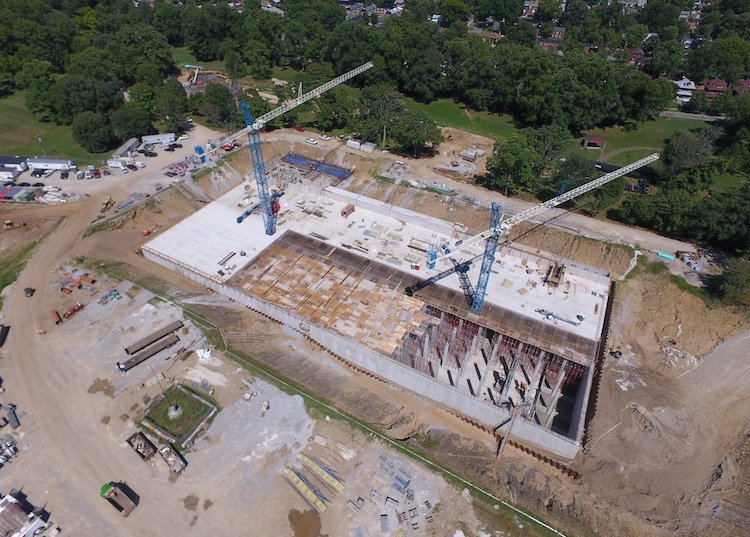Triple bottom line (TBL) success involves a team commitment to balancing not only the economic (financial) components of a project, but also that of social responsibility and environmental stewardship. Projects that seek this achievement must focus equally on each of these goals.
Using progressive design-build delivery, the Southwestern Parkway CSO Basin project in Louisville, KY, realized this success while supporting Louisville MSD’s mission to “provide exceptional wastewater, drainage, and flood protection services for our community.” This $78 million project included the design, construction, and commissioning of a large “capture and release” system that temporarily stores combined sewage during wet weather events. This temporary storage is facilitated by a 20-million-gallon concrete storage tank with associated wash-down systems, and a 30 mgd effluent pump station constructed below the Great Lawn of Shawnee Park which is part of Louisville’s Olmsted Park system. The project was led by Ulliman Schutte and their engineer of record, Burgess & Niple.
While it can be difficult to measure the social and environmental bottom lines on a project, this project experienced overwhelming success in these areas. The utilization of progressive design-build delivery proved instrumental in this achievement and its positive impact on the community. A traditional design-bid-build approach to this project was attempted previously but was replaced during design because of stakeholder pushback and a project schedule that would not allow the Consent Decree deadline to be met.
Social: Perhaps the most rewarding component of this project’s success was the positive impact on the local community and their quality of life. Upon award, the progressive design-build team immediately engaged Louisville MSD and the community through multiple town hall meetings, presentations, and door-to-door discussions in order to understand their recipe for project success. The team held quarterly stakeholder meetings that included local residents and politicians to collaborate on ways to ensure a positive outcome for all, reduce the impact on the surrounding neighborhood, and ensure safety for the public during construction. These efforts resulted in overwhelming community support for a project that had previously been faced with significant opposition. Among the park improvements provided to the public as part of this project were: improvements to athletic courts and spray ground facilities; pavement resurfacing; landscaping; creation of multi-purpose fields; and the addition of an open-air pavilion and restroom structure. Not only did this project provide enhancements for the community, it stimulated the local economy by employing an 86% local labor workforce. The team also exceeded the original inclusion goals with its final participation percentages of minority-owned (20%) and women-owned (13%) businesses. The progressive design-build approach for this project facilitated these results through outreach meetings, alignment of design to the market to create opportunities, and establishment of unique inclusion goals for individual bid packages based upon market capability.
Environmental: One of the most fundamental components of this project’s TBL was the environmental bottom line—a driving force from the inception of the project. This facility was successfully designed and constructed to alleviate combined sewer overflows, while simultaneously preserving and enhancing Olmsted’s historic park and the Great Lawn. The project mitigated three existing combined sewer overflows into the Ohio River, thus providing a significant improvement to regional water quality. Prior to commissioning, sewage laden stormwater would flow directly into the Ohio River during wet weather events, impacting regional wildlife and recreational opportunities. The progressive design-build process allowed this project to find an innovative way to preserve the original Olmsted Park design with defined spaces and vistas while providing a hidden means of collecting and holding combined sewage overflows, thus preventing such overflows from entering the Ohio River.
Financial: Without a doubt, the most measurable component of TBL is the financial results. The use of progressive design-build delivery allowed this project to advance from award to completion in less than three years (two months ahead of schedule). Throughout the design process, Louisville MSD benefitted from early cost assurance and further realized savings from the speed of delivery during the construction phases of the project. The compressed schedule significantly reduced overheads for all team members and Louisville MSD was pleased that the final contract value was well below the original budgeted amount.
A sampling of lessons learned by utilizing progressive design-build on this project includes the following:
- Continuity of team from preconstruction through commissioning allowed the team to implement innovative ideas through collaboration.
- Active communication helped realization of schedule efficiencies and cost benefits while maintaining high levels of quality.
- Community engagement and support was attained through stakeholder meetings and interaction.
This project clearly exemplifies that quantitative triple bottom line (TBL) success can be achieved when all progressive design-build team members are committed to balancing social, environmental, and economic success.

